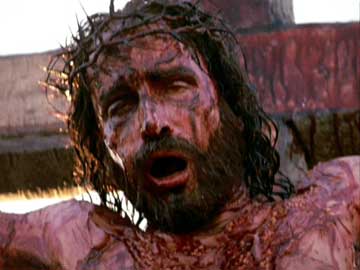
FGF E-Package
The Reactionary Utopian (classic)
April 5, 2012
Did The Passion of the
Christ have “Excessive Violence”?
A classic by Joe Sobran
fitzgerald griffin foundation

Sometimes I think that if people really listened to themselves, I’d be out of a job. When they can’t mean what they say, you are entitled to doubt that they’re saying what they mean.
Few are saying that Mel Gibson had no right to make a film about the Crucifixion. But many are saying he shouldn’t have made it. If they don’t complain that The Passion of Christ is “anti-Semitic” — that is, annoying to some Jews — they complain that its violence is “excessive” and “overdone.” Can they really mean this? Twelve hours of torture are compressed into only two, and that’s too much? Has Gibson left out the refreshment break?
Since there have been lots of earlier films about Christ, you might expect Gibson’s critics to name one that got it right — showed just the proper degree of torment — or at least admit that the earlier, softer versions failed to do justice to the horror of nailing a man to a cross.
In Martin Scorsese’s Last Temptation of Christ, the guy on the cross is shown having sexual fantasies during his agony. Maybe Scorsese’s point is that the victim, even in his agony, has one hell of a libido. Anyway, I don’t remember any complaints that the violence in that absurd version was “deficient” or “underdone.”
The New York Times now brings a fresh angle: “New Film May Harm Gibson’s Career.” Why? Because the film is a flop? Not hardly. It seems that some Jewish Hollywood moguls intend to avenge themselves on the film by doing no further business with Gibson, no matter what profits they may be forgoing.
A new Hollywood blacklist, with only one name on it! Maybe we can have a new round of congressional investigations to uncover Christian infiltration of the film industry. You can’t be too careful. (The New York Post reports that one Israeli politician “said the movie should be banned in his country and called for Gibson to be put on trial.”)
Not everyone shares the hysteria. One Hollywood agent puts the issue in earthy terms: “I don’t think it will hurt [Gibson]. People here will work with the anti-Christ if he’ll put butts in the seats.” The anti-Christ, yes, of course. That’s a no-brainer. But Christ may be another matter.
A decade ago the great English actress Vanessa Redgrave had a scheduled performance in Boston canceled when Jews protested her outspoken anti-Zionism. The Times reported then only that Miss Redgrave’s “politics” — not Jewish pressure — had “hurt her career.”
If the pressure had come from Christians, the story would have been told differently. The Times and other media would have shrieked about “religious fanatics” trying to “impose their views” and blighting “artistic expression.” But today the editorialists aren’t viewing the latest hate campaign with much alarm. Even the “straight” news accounts imply that Gibson has brought it all on himself.
The uproar is amusing because it’s hypocritical. The Passion of the Christ has received an R rating for its violence, and Gibson isn’t objecting to that. But reviewers who have seen it all, and applauded “candor” on the screen as long as it’s ungodly, are howling this time. Gibson is using the new tolerance of film violence for a purpose they loathe: Christian evangelism.
But they can’t even admit that. Hence they are bandying charges of “excessive violence,” “sadism,” “masochism,” and so forth, implying — or saying outright — that Gibson enjoys the spectacle of torture. They don’t explain how he might have made a crucifixion look unpleasant without violating their unspecified proprieties.
Anyone who has read about crucifixion — ancient Rome’s answer to “community service” — knows that Gibson hasn’t exaggerated. When the Gospels were written, Matthew, Mark, Luke, and John didn’t have to explain what it meant: a punishment so savage as to make strong men shudder at its mere mention. The only crucifixion modern men remember, that of Christ, has been rendered largely symbolic by centuries of pious Christian art.
By using the techniques of modern cinema, Gibson has made it seem real again. Those who don’t believe that Christ redeemed us may see in it nothing but needless horror. But Christians are seeing it with something more than horror: inexpressible wonder and gratitude for God’s boundless love.
The Reactionary Utopian archives
Copyright © 2012 by the Fitzgerald Griffin Foundation. All rights reserved. This column was published originally by Griffin Internet Syndicate on February 26, 2004.
Joe Sobran was an author and a syndicated columnist. See bio and archives of some of his columns.
Watch Sobran's last TV appearance on YouTube.
Learn how to get a tape of his last speech during the FGF Tribute to Joe Sobran in December 2009.
To subscribe to or renew the FGF E-Package, or support the writings of Joe Sobran, please send a tax-deductible donation to the:
Fitzgerald Griffin Foundation
344 Maple Avenue West, #281
Vienna, VA 22180
1-877-726-0058
publishing@fgfbooks.com
or subscribe online.
@ 2025 Fitzgerald Griffin Foundation
